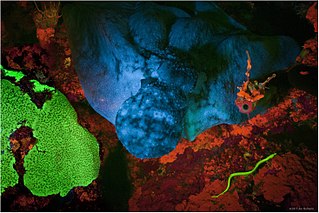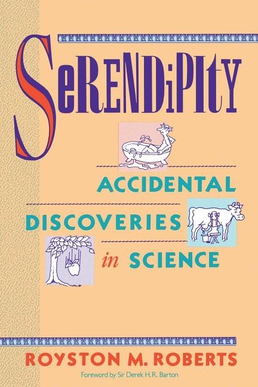
Serendipity is an unplanned fortunate discovery. [2] Serendipity is a common occurrence throughout the history of product invention and scientific discovery. [3]

Serendipity is an unplanned fortunate discovery. [2] Serendipity is a common occurrence throughout the history of product invention and scientific discovery. [3]
The first noted use of "serendipity" was by Horace Walpole on 28 January 1754. In a letter he wrote to his friend Horace Mann, Walpole explained an unexpected discovery he had made about a lost painting of Bianca Cappello by Giorgio Vasari [4] by reference to a Persian fairy tale, The Three Princes of Serendip . The princes, he told his correspondent, were "always making discoveries, by accidents and sagacity, of things which they were not in quest of." [5] The name comes from Serendip , an old Persian name for Sri Lanka (Ceylon), hence Sarandib by Arab traders. [6] It is derived from the Sanskrit Siṃhaladvīpaḥ (Siṃhalaḥ, Sinhalese + dvīpaḥ, island). [7]
The word has been exported into many other languages, with the general meaning of "unexpected discovery" or "fortunate chance". [8] [9]
The term "serendipity" is often applied to inventions made by chance rather than intent. Andrew Smith, editor of TheOxford Companion to American Food and Drink, has speculated that most everyday products had serendipitous roots, with many early ones related to animals. The origin of cheese, for example, possibly originated in the nomad practice of storing milk in the stomach of a dead camel that was attached to the saddle of a live one, thereby mixing rennet from the stomach with the milk stored within. [10]
Other examples of serendipity in inventions include:

Serendipity contributed to entomologist Shaun Winterton discovering Semachrysa jade , a new species of lacewing, which he found not in its native Malaysia, but on the photo-sharing site Flickr. Winterton's discovery was aided by Flickr's ability to present images that are personalized to a user's interests, thereby increasing the odds he would chance upon the photo. Computer scientist Jaime Teevan has argued that serendipitous discovery is promoted by such personalisation, writing that "people don't know what to do with random new information. Instead, we want information that is at the fringe of what we already know, because that is when we have the cognitive structures to make sense of the new ideas." [16]
Serendipity is a design principle for online activity that would present viewpoints that diverge from those participants already hold. Harvard Law professor Cass Sunstein argues that such an "architecture of serendipity" would promote a healthier democracy. Like a great city or university, "a well-functioning information market" provides exposure to new ideas, people, and ways of life. "Serendipity is crucial because it expands your horizons. You need that if you want to be free." [17] The idea has potential application in the design of social media, information searches, and web browsing. [18] [19]
Several uncommonly used terms have been derived from the concept and name of serendipity.
William Boyd coined the term zemblanity in the late twentieth century to mean somewhat the opposite of serendipity: "making unhappy, unlucky and expected discoveries occurring by design". The derivation is speculative, but believed to be from Nova Zembla, a barren archipelago once the site of Russian nuclear testing. [20] [21]
Bahramdipity is derived directly from Bahram Gur as characterized in The Three Princes of Serendip . It describes the suppression of serendipitous discoveries or research results by powerful individuals. [22]
In addition, Solomon & Bronstein (2018) further distinguish between perceptual and realised pseudo-serendipity and nemorinity. [23]
The history of science covers the development of science from ancient times to the present. It encompasses all three major branches of science: natural, social, and formal. Protoscience, early sciences, and natural philosophies such as alchemy and astrology during the Bronze Age, Iron Age, classical antiquity, and the Middle Ages declined during the early modern period after the establishment of formal disciplines of science in the Age of Enlightenment.
Science is a rigorous, systematic endeavor that builds and organizes knowledge in the form of testable explanations and predictions about the world. Modern science is typically divided into three major branches: the natural sciences, which study the physical world; the social sciences, which study individuals and societies; and the formal sciences, which study formal systems, governed by axioms and rules. There is disagreement whether the formal sciences are science disciplines, because they do not rely on empirical evidence. Applied sciences are disciplines that use scientific knowledge for practical purposes, such as in engineering and medicine.

An invention is a unique or novel device, method, composition, idea or process. An invention may be an improvement upon a machine, product, or process for increasing efficiency or lowering cost. It may also be an entirely new concept. If an idea is unique enough either as a stand-alone invention or as a significant improvement over the work of others, it can be patented. A patent, if granted, gives the inventor a proprietary interest in the patent over a specific period of time, which can be licensed for financial gain.
Discovery is the act of detecting something new, or something previously unrecognized as meaningful. Concerning sciences and academic disciplines, discovery is the observation of new phenomena, new actions, or new events and providing new reasoning to explain the knowledge gathered through such observations with previously acquired knowledge from abstract thought and everyday experiences. A discovery may sometimes be based on earlier discoveries, collaborations, or ideas. Some discoveries represent a radical breakthrough in knowledge or technology.

Science studies is an interdisciplinary research area that seeks to situate scientific expertise in broad social, historical, and philosophical contexts. It uses various methods to analyze the production, representation and reception of scientific knowledge and its epistemic and semiotic role.
George de Mestral was a Swiss electrical engineer who invented the hook and loop fastener which he named Velcro.
Many fields of scientific research in the Soviet Union were banned or suppressed with various justifications. All humanities and social sciences were tested for strict accordance with historical materialism. These tests served as a cover for political suppression of scientists who engaged in research labeled as "idealistic" or "bourgeois". Many scientists were fired, others were arrested and sent to Gulags. The suppression of scientific research began during the Stalin era and continued after his death.

Grounded theory is a systematic methodology that has been largely applied to qualitative research conducted by social scientists. The methodology involves the construction of hypotheses and theories through the collecting and analysis of data. Grounded theory involves the application of inductive reasoning. The methodology contrasts with the hypothetico-deductive model used in traditional scientific research.

Sociology as a scholarly discipline emerged, primarily out of Enlightenment thought, as a positivist science of society shortly after the French Revolution. Its genesis owed to various key movements in the philosophy of science and the philosophy of knowledge, arising in reaction to such issues as modernity, capitalism, urbanization, rationalization, secularization, colonization and imperialism.
The Three Princes of Serendip is the English version of the story Peregrinaggio di tre giovani figliuoli del re di Serendippo, published by Michele Tramezzino in Venice in 1557. Tramezzino claimed to have heard the story from one Cristoforo Armeno, who had translated the Persian fairy tale into Italian, adapting Book One of Amir Khusrau's Hasht-Bihisht of 1302. The story first came to English via a French translation, and now exists in several out-of-print translations. Serendip is the Classical Persian name for Sri Lanka (Ceylon).

Patsy O’Connell Sherman was an American chemist and co-inventor of Scotchgard, a 3M brand of products, a stain repellent and durable water repellent.
In science, priority is the credit given to the individual or group of individuals who first made the discovery or propose the theory. Fame and honours usually go to the first person or group to publish a new finding, even if several researchers arrived at the same conclusion independently and at the same time. Thus, between two or more independent discoverers, the first to publish is the legitimate winner. Hence, the tradition is often referred to as the priority rule, the procedure of which is nicely summed up in a phrase "publish or perish", because there are no second prizes. In a way, the race to be first inspires risk-taking that can lead to scientific breakthroughs which is beneficial to the society. On the other hand, it can create unhealthy competition and incentives to publish low-quality findings, which can lead to an unreliable published literature and harm scientific progress.

The Society for Scientific Exploration (SSE) is a group committed to studying fringe science. The opinions of the organization in regard to what are the proper limits of scientific exploration are often at odds with those of mainstream science. Critics argue that the SSE is devoted to disreputable ideas far outside the scientific mainstream.
The concept of multiple discovery is the hypothesis that most scientific discoveries and inventions are made independently and more or less simultaneously by multiple scientists and inventors. The concept of multiple discovery opposes a traditional view—the "heroic theory" of invention and discovery. Multiple discovery is analogous to convergent evolution in biological evolution.
Velcro, officially known as Velcro IP Holdings LLC and trading as Velcro Companies, is a British privately held company, founded by Swiss electrical engineer George de Mestral in the 1950s. It is the original manufacturer of hook-and-loop fasteners, which de Mestral invented.

The role of chance, or "luck", in science comprises all ways in which unexpected discoveries are made.
Logology is the study of all things related to science and its practitioners—philosophical, biological, psychological, societal, historical, political, institutional, financial. The term "logology" is back-formed from the suffix "-logy", as in "geology", "anthropology", etc., in the sense of the "study of science". The word "logology" provides grammatical variants not available with the earlier terms "science of science" and "sociology of science", such as "logologist", "logologize", "logological", and "logologically". The emerging field of metascience is a subfield of logology.
To be blown off course in the sailing ship era meant be to diverted by unexpected winds, getting lost possibly to shipwreck or to a new destination. In the ancient world, this was especially a great danger before the maturation of the Maritime Silk Road in the Early Middle Ages, finding expression in the writing of Cosmas Indicopleustes. Even in later eras, the ship could attempt to limit its divergence by tacking or heaving to, but it was often difficult to keep track by mere celestial navigation before the invention of the marine chronometer in the late 18th century.

Serendipity: Accidental Discoveries in Science is a 1989 popular science book by the chemist Royston M. Roberts. It received positive and mixed reviews; critics found it informative and entertaining, though some indicated that it contained errors.
{{cite book}}: CS1 maint: multiple names: authors list (link){{cite book}}: CS1 maint: location missing publisher (link)